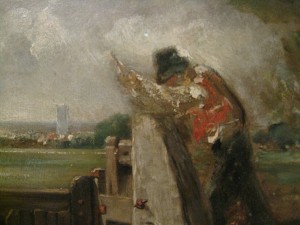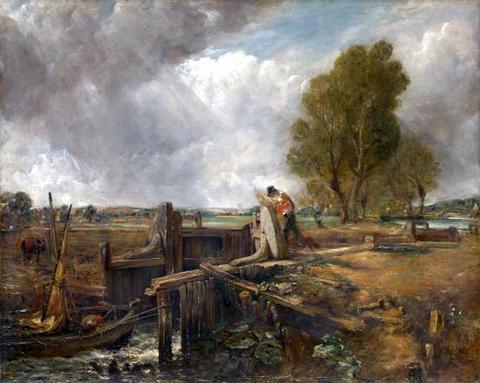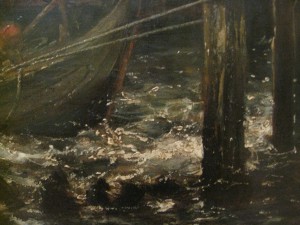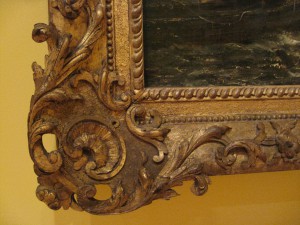My parents had a Constable hanging on the wall of our family home for years . . . reproductions of Constable’s idyllic English landscapes like ‘The Hay Wain’ were popular after WWII. John Constable (1776-1837) painted ‘Study of ‘A boat passing a lock’’ (owned by the National Gallery of Victoria) between 1823 and 1826: the sluice gates of Flatford lock on the river Stour are being opened by the lock-keeper to enable a small barge to continue along the river—a scene Constable observed many times during his childhood. Constable’s father owned and operated a watermill near the Flatford lock in the Stour Valley, Suffolk, and as a young boy Constable was outdoors, observing and sketching the changing of the seasons, the plant life, the interplay of shadow and sunlight on the landscape, and the movement of water in the locks and streams.
I visited Flatford in ‘Constable country’ many years ago and I still recall the beauty of an ancient landscape in tune with nature and manual labour; I could envisage Constable sketching as he sat on the banks of the Stour River—the Dedham church on the horizon, the barge horse plodding peacefully along the tow-path beside the river as the sluice gates open, the flatness of the land emphasising the sky. Constable believed that the sky was “the chief organ of sentiment” and he called his systematic studies of moving clouds, ‘skying’. In Study of ‘A boat passing a lock’ painting (the Melbourne Lock) the sky is painted using rapid brushstrokes to create a sense of wind and weather; the burst of rain provides a dramatic, yet non-violent presence.
Pastoral landscapes reflected 19th century Romanticism, with an emphasis on nature, freedom and feeling, not only characterised in painting but in all forms of the arts including music, literature and poetry. William Wordsworth rejected the poetic conventions of the Augustan poets just like Constable rejected (yet respected) the pictorial language of 17th century landscape painters (such as Claude Lorrain and Jacob van Ruisdael), replacing it with a greater degree of reality. Constable’s en plein air paintings of the place of his childhood reflected his love for the English countryside, yet he refused to romanticise nature.
 Constable overturned the traditional concept of a ‘finished’ picture with his spontaneity of rapidly applied paint; he believed this technique most accurately captured time and place. Even though Constable used more finished brushwork in the Melbourne Lock, the composition is broken with touches of colour that enliven the painted surface. Flecks of white paint called Constable ‘snow’ are scattered across the painting adding sparkle and an illusion of movement. You could say he was an English ‘Romantic’ Impressionist.
Constable overturned the traditional concept of a ‘finished’ picture with his spontaneity of rapidly applied paint; he believed this technique most accurately captured time and place. Even though Constable used more finished brushwork in the Melbourne Lock, the composition is broken with touches of colour that enliven the painted surface. Flecks of white paint called Constable ‘snow’ are scattered across the painting adding sparkle and an illusion of movement. You could say he was an English ‘Romantic’ Impressionist.
There is no doubt that the freshness and naturalism of Constable’s paintings influenced many revolutionary French painters at this time. The Hay Wain (1821) was exhibited at the Paris Salon in 1824 where it won a gold medal, and was admired by Gericault and Delacroix. However, Constable’s ‘loose’ painterly technique horrified many English art critics; in 1828 the following comment was written about his painting, Chain pier, Brighton, in The Morning Chronicle:
It is like keeping up the scaffolding after the house is built. It is evident that Mr. Constable’s landscapes are like nature; it is still more evident they are paint. There is no attempt to conceal art.
In the Preface to the English Landscape Scenery (1830), Constable wrote (scoffed):
In art there are two modes by which men aim at distinction . . . In the first, he forms a style upon the study of pictures, and produces either imitative or eclectic art; in the second, by a close observation of nature, he discovers qualities existing in her which have never been portrayed before, and thus forms a style which is original.
Constable was so committed to this revolutionary and uncompromising artistic technique that it was difficult for him to be accepted into London’s Royal Academy of Arts. The Melbourne Lock was acquired in 1951 by the NGV, most likely a preliminary study for Constable’s 1826 landscape painting, A Boat passing a lock, which he selected to present to the Royal Academy as his Diploma painting when he was finally elected Royal Academician in 1829. The ornately carved wood frame of the Melbourne Lock is gilded and of the 18th century British Regency Empire style.
Constable’s Flatford lock paintings, including the Melbourne Lock, are his direct observations of a place with which he was familiar. He painted romantic, yet true-to-life images of agrarian England; people working in harmony with nature at a time when Europe was gripped by the Industrial Revolution.
I apologise for the poor (featured) image of this painting. The three insets of details of the painting are photos taken by myself at NGV. Google Art Project has a wonderful image of the painting online.








Great stuff Denise (again)! I’ll be drawing on it when I’m in front of the Lock Keeper when next in NGVI.
Thanks Barrie, I’m sure you could think of many William Wordsworth poems that respond to the essence of this Constable painting.